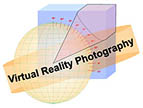

![]() Ask the VR Photography Experts
Ask the VR Photography Experts
![]()
Q: I have taken a photography class at school and the instructor totally confused me on whether you need a high /low shutter speed or a high/low F-stop when taking outdoor pictures when there is an overcast. Can you help me out?
![]()
A: Aperture (f/stop) and shutter speed are both used to control the amount of light that reaches the film. Opening the aperture wider (such as opening from f/16 to f.2.8) allows more light to get through the lens. (Note that each full f/stop allows either twice or half as much light through as the previous one - depending upon which direction you're going. f/4 allows half as much light as f/2.8. f/5.6 allows twice as much light as f/8).
Shutter speed works similarly, but controls the amount of light reaching the film plane via the length of time the shutter is open. 1/125 sec. allows twice as much light to reach the film as 1/250 sec. 1/30 sec. allows only half as much light as 1/15 sec., because the film is only exposed for half the time.
Shutter speed and aperture are used in combination to achieve the desired exposure result. You can increase one while decreasing the other an equal amount to get the same light exposure on film. (Remember that each stop, whether shutter speed increment or f/stop, allows for 1/2x or 2x the light transmission.)
For example, if you have an indicated exposure of 1/30 sec. at f/8, you could also shoot that same picture and properly expose it at:
| 1/4 sec | @ | f/22 |
| 1/8 sec | @ | f/16 |
| 1/15 sec | @ | f/11 |
| 1/30 sec | @ | f/8 |
| 1/60 sec | @ | f/5.6 |
| 1/125 sec | @ | f/4 |
| 1/250 sec | @ | f/2.8 |
| 1/500 sec | @ | f/2 |
The same amount of light would reach the film in every combination above. Note that as the length of the exposure (shutter speed) decreases, aperture size increases (f/22 is a small aperture while f/4 is a large one -- the numbers are just like fractions, i.e. 1/22 vs. 1/4).
On a cloudy day outdoors, you'll generally want to open the lens aperture wider (such as f/2.8 or f/4). However, if you're shooting action or moving subjects, you'll want to give priority to a fast shutter speed (in order to "freeze" the action).
- Scott Highton